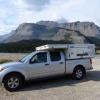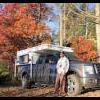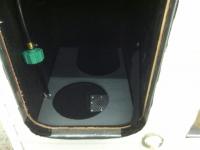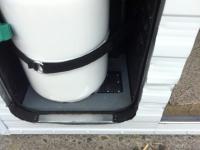
Leak behind siding
#21

Posted 21 December 2012 - 02:16 AM
#22

Posted 21 December 2012 - 04:19 AM
Yes! This is required by NFPA 1192 Section 5.2.6 Ventilation of Compartments Containing Propane Containers.
I did not see such a drain when I was there, I looked through the compartment but missed it. And when Terry supplied my parts no drain was part of them. That's not a problem, I've a variety of drain fittings left over from last year's boatbuilding. And I have perfectly good lathe and milling machine I could make my own. I did see the ventilation in the door I got, of course, and that's installed already. Had to modifiy the installation due to the shell framework not fitting the compartment liner.
Could you put up a photo showing the drain?
Let's wander through NFPA 1192, in this case the proposed revised 2014 version, which I happened to trip over, the relevant section:
5.2.6 Ventilation of Compartments Containing Propane Containers.
5.2.6.1 Compartments shall be ventilated at or near the top and at the extreme bottom to facilitate
diffusion of vapors.
5.2.6.2 The compartment shall be ventilated with at least two vents, each having an aggregate free
area equal to at least 0.5 in.2 (323 mm2) for each 7 lb (102 mm2/kg) of the total propane fuel capacity
of the maximum number of the largest cylinders the compartment can hold.
5.2.6.3 If the lower vent is located in the access door or wall, the bottom edge of the vent shall be
flush with the floor level of the compartment.
12 First Draft Report: Proposed 2014 Edition NFPA 1192
5.2.6.4 The top vent shall be located in the access door or wall, with the bottom of the vent within
12 in. (305 mm) of the ceiling of the compartment.
5.2.6.5 Vents shall have an unrestricted discharge to the outside atmosphere.
5.2.6.6 Doors or panels providing access to valves shall not be equipped with locks or require
special tools to open.
Note this is not about water damage or water drainage at all. It's about ventilation of the compartment to the atmosphere. in the case of two 10 lb propane tanks, with is current with FWC that's roughly 2000 mm2 of vent area between the two vents. Flush with the floor level means the plastic structure of the compartment lining will have to have an opening at the floor, where the bottom of the 1" x 1" tubing of the aluminum structure now occupies. And unrestricted access to the outside atmosphere seems clear enough, a drain through the plywood floor then up against the truck bed, that's restricted, though it will drain water. Who needs structure? Well in another section they specify just how good the tank anchors, the door and so on have to be for structure.
I do agree with no lock, so you can get at the valves to turn them off in a emergency, maybe. And I do agree that propane compartments need ventilation to get rid of any leaking propane to the atmosphere.
Other bits in the document. No enclosed propane piping, not in walls, closed compartments and so on (some of that part sounds like the only approved piping location is on the exterior of the camper) until you start reading the rules concerning nearness to openings, fuel fills and so on. Probably a good percentage of FWC campers have heater exhausts or their air intakes too near to fuel fills or openings. And in this future world forget unvented heaters, not allowed.
Reading all the warning and other types of labels that will be required the smaller FWC campers won't need siding, you would not see the siding for the labels, and the inside walls nearly as bad. And here is the exact full text of one label about the required smoke detectors note not the only label connect with those detectors.
"Test smoke alarm operation after vehicle has been in storage, before each trip and at least once per week during use. May result in death or serious injury."
That's it, I don't think I'd do any testing with that advice. I am not looking for death or serious injury
Or how about this to keep you from breaking camp "Do not utilize this RV unless fully setup because a secondary means of escape is not available. May result in death or serious injury." Note their standards on size of door will rule out the door of most FWC as a means of escape, they have standards on what's a door, and mine does not meet the height requirement. And nearly every label they have in their huge supply includes the death or serious injury clause. Guess they expect us to not use RV's. More likely they have very limited experience of truck RV, especially those like the FWC.
#24

Posted 23 December 2012 - 11:03 PM
Is this the plastic compartment that's sealed to prevent propane getting from it into the camper?
Question is if FWC is making the mentioned drain a standard part of their build and exactly where do they put it? There are 4 layers of plywood below that compartment and a drain installed through all that could be a route back in as well as draining for the compartment. The compartment hatch is a ventilated one to the outside, which I'd expect would keep condensation down. So far in recent heavy rain the compartment and wood outside of it is staying perfectly dry. Final sealing awaits finishing the propane distribution piping.
Yes, I was referring to the plastic compartment. I don't want to misquote Terry from FWC, but I think the issue was that if water entered that area through the vented door it would have no easy way out and could then leak through any small holes in the silicone that seals the compartment. He told me to look for signs of water on the board with the two cutouts that the propane tanks sit in or rust on the bottom of the tanks. I think the drain may be standard on new campers. I got the idea that the exact placement was not that critical, just make sure to caulk the hole and add a screen to keep critters out.
#25

Posted 24 December 2012 - 02:48 AM
Yes, I was referring to the plastic compartment. I don't want to misquote Terry from FWC, but I think the issue was that if water entered that area through the vented door it would have no easy way out and could then leak through any small holes in the silicone that seals the compartment. He told me to look for signs of water on the board with the two cutouts that the propane tanks sit in or rust on the bottom of the tanks. I think the drain may be standard on new campers. I got the idea that the exact placement was not that critical, just make sure to caulk the hole and add a screen to keep critters out.
Oh, I'll do a bit more than that. I've got a bunch of left over marine drain fittings. I'll place the hole forward enough so it comes out in one of the open spaces in the bottom plywood. Then I'll fit a flush drain fitting that will be sealed against letting water into the upper layers and who's end will protrude into the open space a little. So any water will drip directly onto the truck bed. I'm already treating that entire bottom with preservative. Not a perfect solution, but it should do fine.
In my case because the plastic liner did not fit through the aluminum frame I had to cut 1" off the liner to get it fit into the alcove. So with no sealing any water would just drain onto the wood floor and under the aluminum outside of the liner. However that join is being sealed and calked, as it's also a way for leaking propane to get inside the camper. I won't do the final sealing of the plastic liner until I've got all the propane distribution done that comes out of it and has to be sealed too. Every possible path for propane to get into the camper will be sealed when it's all done. (and nearby in the cabinet spaces around that compartment there will be a propane sensor that will drive a shut off solenoid if it detects propane.)
And because the frame hole was not the right size the hatch had to have a 1/2" thick ring of Seaboard to fill the hatch flange. That seaboard is sealed to the siding, the aluminum frame piece is tape sealed under the sealing, and the outside of the Seaboard sealed to the hatch. That offsets the hatch flange enough to clear the siding around the offsize hole. Since that was all done we have had very strong winds mixed with heavy rain pouring against it for days. All dry inside, just checked a bit ago, the tarp that I had folded beside the camper went walkabout over 100 yards, that's what sort of wind we had. Any water that accumulates inside the compartment would likely have to come from condensation. And the compartment hatch does have ventilation, though it also has a foam seal which would prevent blowing in anywhere except the vent slots.
Blowing in the vent slots on the door is not very likely if there is no drain as there is no air passage any other direction out of the compartment. Well, then we go and put in a drainage passage on a different side of the compartment. When hit by wind and rain on the back it's going to take on rain.
Be interesting to know when you get it apart if the drain is the center of the damage.
0 user(s) are reading this topic
0 members, 0 guests, 0 anonymous users

















